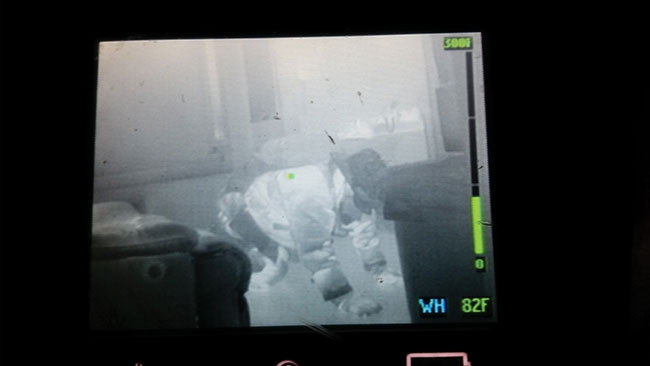
Timbits: July 2015
Tim Llewellyn
Features Fire Ground TrainingThermal imaging cameras (TICs) have been used in the fire service for interior structural firefighting since the 1990s. Every fire department that participates in interior firefighting operations should have at least one TIC in its equipment arsenal. The TIC should be used regularly at incidents and in training.
 Using only the image from the TIC display Every fire department that participates in interior firefighting operations should have at least one TIC
Using only the image from the TIC display Every fire department that participates in interior firefighting operations should have at least one TICSome fire-department leaders are hesitant to allow TICs to be used during training operations – particularly for live-fire training – due to their high cost and the justifiable fear of breakage or damage. While this is understandable, leadership must understand that firefighters need adequate training on equipment for situations and environments they are likely to face.
With a TIC, firefighters can see through smoke and darkness, which allows them to do interior tasks more quickly and safely. The images displayed on the screen can help firefighters identify travel paths, obstacles and heat sources, and to find fire victims with relative ease compared to traditional blind, search-by-hand techniques.
The first step to successful TIC training is to take the device off of the truck and bring it along during every structural firefighting drill (and incident) – even if the drill does not pertain to TIC use. Too often the TIC is left behind in favour of irons, hooks and cans. Training officers should set up the drills so that firefighters operate in teams that are equipped just as they would be if they came off of the fire truck at an actual incident. I can recall several fires at which I left the TIC in the cab simply because I wasn’t in the habit of taking it with me.
Here is a simple and safe, but realistic TIC drill that can be performed at almost any fire house with minimal equipment. A furnished office or residential space works well. It is important to use rooms with furniture or other obstacles rather than empty training rooms. Ideally, run the drill when it is dark outside, then turn off the lights and close the blinds; make the area as dark as possible.
Divide the large group of firefighters into teams of two or three firefighters – one firefighter (the officer or team leader) has the TIC and the others are the firefighters who will search the areas. Give the crew the task of moving through the darkened area to perform a primary search using an oriented-search technique. The leader holds a position – the oriented position – usually at a door or entrance, or on a hoseline, while verbally directing the firefighters into the room. Using only the information from the TIC display, the leader must communicate what is seen or not seen, or areas that need to be searched. The key to success with this drill is that the TIC holder communicates only what is seen on the display, and not what may be noticed via any ambient light. This will simulate, as closely as possible, navigating through a smoke-filled structure.
From the oriented position, the leader scans the room with the TIC. Remaining at the oriented position, the leader, using the information on the TIC, directs a firefighter into the room and around hazards. Any area in the room that the leader cannot see on the TIC display , such as the far side of a bed or desk or inside a closet, must be searched by hand. The leader directs the searching firefighter to the unseen areas for a manual search.
The team leader should not only keep track of the searching firefighter(s) with the TIC, but should also monitor the fire conditions and other fire-ground activities.
Once the firefighter has searched the area, the team leader then verbally directs the firefighter around any obstacles and back to the oriented position in the quickest and safest manner possible. The team then moves to the next area or room, using the TIC as a guide, and repeats the process until the primary search is complete.
This drill focuses on communication between what is observed on the TIC display and the searching firefighters. If the team leader can not make out what is observed on the TIC, or there are obstacles blocking the view, that area must be searched by hand.
Effective TIC use starts with learning and practising the basics – observing what is seen and communicating that information to others timely and efficiently. That said, firefighters must not rely solely on TICs for navigating smoke-filled structures. As with any technology, TICs can fail and are only as reliable as the batteries that power them. We must be proficient at basic search techniques as well as TIC-assisted searches. As always, training is key.
Tim Llewellyn is a firefighter for the Allegheny County Airport Authority in Pittsburgh, Penn., and an instructor for a number of fire academies and training faculties. llewllyn.fire@gmail.com
Print this page